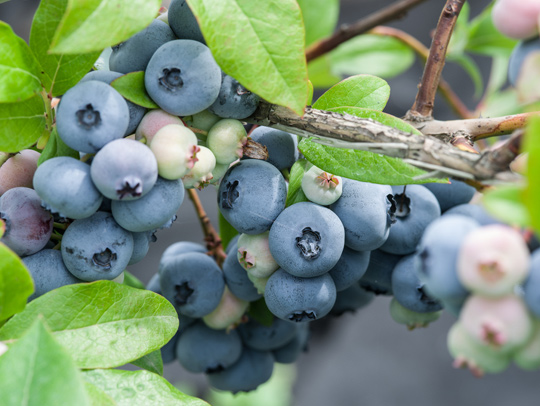U.S. Highbush Blueberries Gain Expanded Access to High-Demand Markets in China, the Philippines
May 21, 2020 | 4 min to read

FOLSOM, Calif. – The North American Blueberry Council (NABC) today expressed appreciation for progress made in ongoing U.S. trade negotiations with China in phase 1 of the trade agreement disclosed earlier this year. Among the new tenets of the agreement is expanded market access for fresh U.S. highbush blueberries. Previously, China only permitted imports of dried and frozen U.S. highbush blueberries. Additionally, the Philippines will formally open its market to fresh U.S. highbush blueberries, making the U.S. the only country with official access to the Philippine market for fresh blueberries.
China Market Access
The updated trade agreement serves as a symbol of positive momentum in trade relations with China and the potential the Chinese market holds for the U.S. highbush blueberry industry. More work remains to be done, including addressing the 75% tariff imposed on blueberries exported from the U.S.
“The NABC has been working diligently for many months to ensure this opportunity would open up for U.S. blueberry growers,” said Alicia Adler, vice president of NABC, who’s charged with overseeing the NABC’s market access efforts and the U.S. Highbush Blueberry Council’s (USHBC) global programs. “This significant milestone could not have been achieved without close collaboration between the U.S. government agricultural negotiators, key industry stakeholders from all growing regions and a team of technical export advisers at Bryant Christie Inc.”
The Chinese market represents a significant opportunity for the U.S. highbush blueberry industry, as an increasing number of Chinese consumers prefer imported fruits due to their superior taste, nutrition and appearance. Consumers also are demonstrating clear interest in blueberries specifically. From 2014 to 2018, the volume of per capita fresh blueberry consumption in China increased by more than 400%.
“USHBC is in a position to help U.S. growers sell more blueberries in China, which represents significant growth potential for the industry,” said David Arena, chair of the USHBC Export Committee and president of Frank Donio Inc. based in New Jersey. “Opening the Chinese market for fresh blueberries will help grow demand, ultimately supporting USHBC’s strategic goal of doubling exports by 2025, with a focus on high-opportunity markets in North and Southeast Asia.”
Key updates to the phase 1 trade agreement relevant to blueberries include:
- Fresh blueberries must be commercially produced from the states of California, Florida, Georgia, Indiana, Louisiana, Michigan, Mississippi, New Jersey, North Carolina, Oregon and Washington.
- Blueberries must come from packing houses registered and approved by USDA, and the registered packing houses must have a system to ensure all fruit can be traced back to the supplying orchards.
- Each packing house must retain a list of registered supplying orchards that can be made available at the request of the USDA or GACC, the agency in China that corresponds with the USDA’s Animal and Plant Health Inspection Service (APHIS).
- APHIS will supply the list of approved packing houses to GACC annually.
Philippines Market Access
The U.S. has been providing fresh highbush blueberries to the Philippine market, but only in an intermittent capacity, with sales limited to hotels, restaurants and high-end supermarkets. With official access to this vibrant market, the sales growth potential is significant. The USDA reports that annual U.S. sales have averaged $150,000 over the last five years, but trade experts project that sales could reach $500,000 this season, and as much as $1 million annually in the future. To maximize sales potential, a concerted marketing effort will be put in place to increase consumer awareness on the availability, quality and health benefits of fresh U.S. highbush blueberries.
Licensed U.S. highbush blueberry importers will need to follow the Philippine Department of Agriculture’s (DA) usual regulations for fresh fruit importation:
- Importers must secure a Sanitary and Phytosanitary Import Clearance (SPSIC) from the DA’s Bureau of Plant Industry.
- Products must not load for export before their issuance.
- All products must be shipped within 20 days following their issuance and must arrive in the Philippines within 60 days from the must ship-out date.
“As a global leader for the blueberry industry, the North American Blueberry Council (NABC) is committed to opening markets and creating volume-driving opportunities for our growers,” explained NABC president Kasey Cronquist who also leads the U.S. Highbush Blueberry Council’s (USHBC) domestic and international programs. “This new agreement reflects the commitment, vision and direction of our leadership to continually expand the category.”
For information related to the blueberry industry, please visit nabcblues.org or ushbc.org.
###
About the North American Blueberry Council
Since 1965, the North American Blueberry Council (NABC) has been the voice of the blueberry industry in the U.S. and Canada. NABC’s members represent approximately 70% of the North American highbush blueberry crop. NABC was instrumental in the establishment of the U.S. Highbush Blueberry Council (USHABC), a federal agriculture research and promotion program with independent oversight from the United States Department of Agriculture (USDA). Learn more at nabcblues.org.
